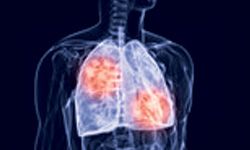Dinutuximab Plus Irinotecan Misses Overall Survival End Point in R/R SCLC
The addition of the dinutuximab injection to irinotecan did not improve overall survival in patients with relapsed/refractory small cell lung cancer, failing to meet the primary end point of the phase III DISTINCT trial, according to top-line results announced in a press release from United Therapeutics, developer of dinutuximab.

The addition of the dinutuximab (Unituxin) injection to irinotecan did not improve overall survival in patients with relapsed/refractory small cell lung cancer (SCLC), failing to meet the primary end point of the phase III DISTINCT trial, according to top-line results announced in a press release from United Therapeutics, developer of dinutuximab.1
The safety profile of dinutuximab plus irinotecan was found to be consistent with prior studies, and the toxicities are currently included in the dinutuximab product label. The most common adverse events (AEs) associated with dinutuximab are infections, infusion reactions, hypokalemia, hypotension, pain, fever, and capillary leak syndrome, which occur in ≥5% of patients who take the drug.
For the combination of dinutuximab and irinotecan compared with irinotecan alone, the most common AEs, respectively, were pain (85% vs. 16%), pyrexia (72% vs. 27%), thrombocytopenia (66% vs. 43%), lymphopenia (62% vs. 36%), infusion reactions (60% vs. 9%), hypotension (60% vs. 3%), hyponatremia (58% vs. 12%), increased alanine aminotransferase (56% vs. 31%), anemia (51% vs. 22%), vomiting (46% vs. 19%), diarrhea (43% vs. 15%), hypokalemia (43% vs. 4%), capillary leak syndrome (40% vs. 1%), neutropenia (39% vs. 16%), urticaria (37% vs. 3%), hypoalbuminemia (33% vs. 3%), increased aspartate aminotransferase (28% vs. 7%), and hypocalcemia (27% vs. 0%).
United Therapeutics plans to share the full data from phase III of the DISTINCT trial at an upcoming conference and in peer-reviewed publications.
“We're clearly disappointed with the DISTINCT results but we'll continue to seek out underappreciated avenues in our core therapeutic areas addressing rare diseases in oncology and pulmonary hypertension. In addition, we look forward to announcing the results of our INCREASE study by the end of the first quarter or shortly thereafter,” said Gil Golden, MD, PhD, Chief Medical Officer of United Therapeutics, in a statement.1
The phase II data were presented at the 2018 American Society of Clinical Oncology (ASCO) Annual Meeting. In the 12 participants evaluated, the best response observed was a partial response, and this occurred in 25% of patients (n = 3). Additionally, the efficacy analysis showed that 50% of patients had stable disease (n = 6), and 25% of patients had progression of disease (n = 3). Twenty-five percent of patients died following a mean of 136 days on the study ( n = 4).2
Overall, 177 AEs were reported from the safety analysis. Of those AEs, 10 were serious. In 83% of participants out of 10 patients total, 22 cases of diarrhea were reported, which were mostly grade 1. Additionally, 75% of patients reported pain (n = 9), and these cases were also mainly grade 1 in severity. Forty-nine percent of the AEs related to pain were reported by a single patient.
Investigators concluded from the study that patients with relapsed/refractory SCLC could tolerate dinutuximab up to dose 17.5mg/m2in combination with irinotecan, and they proceeded with part 2, a phase III trial.
DISTINCT is a 2-part open-label, randomized, international, multicenter study of dinutuximab and irinotecan versus irinotecan alone for the treatment of relapsed/refractory SCLC in the second-line setting. The phase III portion of the study randomized patients from 198 cancer centers in 22 countries across North American, Europe, and Asia-Pacific 2:2:1 to receive the irinotecan alone (n = 190), dinutuximab plus irinotecan (n = 187), or topotecan monotherapy (n = 94). The secondary end points of the study included the safety of dinutuximab versus irinotecan, the pharmacokinetics of patients treated with dinutuximab, and 2 comparisons of progression-free survival, objective response, partial response, and clinical benefit in the combination arm compared to the irinotecan arm and separately compared with the topotecan arm.
The study also had an exploratory end point, which was to assess how selected biomarkers relate to the survival of patients who received dinutuximab treatment.
To enroll in the study, individuals were required to have SCLC confirmed by histology or cytology, documented relapse or progressive disease, and no curative therapy. These individuals were also required to have a life expectancy of at least 12 weeks, an ECOG performance score of 0 to 1, adequate bone marrow and hepatic function, and calculated creatinine clearance ≥30 mL/minute or serum creatinine ≤1.5 times below the upper limit of normal.
Patients with SCLC who were candidates for re-treatment with their original platinum-based regimen as second-line therapy or those who had prior treatment with irinotecan, topotecan, or dinutuximab were ineligible to enroll in the study. Patients were also excluded if they had active brain metastases, mixed SCLC and nonsmall cell lung cancer, had previous or concurrent cancer that is distinct in primary site or histology from the cancer being evaluated in this study.
Dinutuximab has a prior indication for the treatment of pediatric patients with neuroblastoma who achieve at least a partial response to prior first-line multiagent, multimodality therapy. The agent continues to be studied in the phase III ANBL1221 study. A meeting between the FDA and United Therapeutics is planned for the first half of 2020 to discuss their supplemental Biologic License Application for dinutuximab plus irinotecan for the treatment of relapse/refractory neuroblastoma.1
References
- United Therapeutics Announces Study of Unituxin® (dinutuximab) for Small Cell Lung Cancer Did Not Meet Primary Endpoint [news release]. Silver Spring, Maryland: United Therapeutics; February 3, 2020.https://bit.ly/2ttlqOU. Accessed February 3, 2020.
- Edleman ME, Jaun O, Navarro A, et al. A two-part, open-label, randomized, phase 2/3 study of dinutuximab and irinotecan versus irinotecan for second-line treatment of subjects with relapsed or refractory small cell lung cancer.J Clin Oncol. 36, no. 15_suppl.